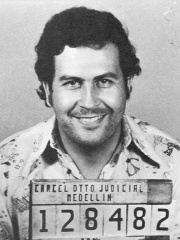

The Most Famous
MAFIOSOS from Colombia
Top 2
The following people are considered by Pantheon to be the most legendary Colombian Mafiosos of all time. This list of famous Colombian Mafiosos is sorted by HPI (Historical Popularity Index), a metric that aggregates information on a biography's online popularity.

1. Pablo Escobar (1949 - 1993)
With an HPI of 84.96, Pablo Escobar is the most famous Colombian Mafioso. His biography has been translated into 99 different languages on wikipedia.
Pablo Emilio Escobar Gaviria (; Spanish: [ˈpaβlo eskoˈβaɾ]; 1 December 1949 – 2 December 1993) was a Colombian drug lord, narcoterrorist, and politician who was the founder and leader of the Medellín Cartel. Dubbed the "King of Cocaine", Escobar was one of the wealthiest conventional criminals in history, having amassed an estimated net worth of US$30 billion by his death, while his drug cartel monopolized the cocaine trade into the US in the 1980s and early 1990s. Born in Rionegro and raised in Medellín, Escobar studied briefly at Universidad Autónoma Latinoamericana of Medellín but left without graduating; he instead began engaging in criminality, selling illegal cigarettes and fake lottery tickets, as well as participating in motor vehicle theft. In the early 1970s, he began to work for various drug smugglers, often kidnapping and holding people for ransom. In 1976, Escobar founded the Medellín Cartel, which distributed powder cocaine, and established the first smuggling routes from Peru, Bolivia and Ecuador, through Colombia and eventually into the United States. Escobar's infiltration into the US created exponential demand for cocaine and by the 1980s it was estimated Escobar led monthly shipments of 70 to 80 tons into the US from Colombia. He quickly became one of the richest people in the world, but constantly battled rival cartels domestically and abroad, leading to massacres and the murders of police officers, judges, locals, and prominent politicians. In the 1982 Colombian parliamentary election, Escobar was elected as an alternate member of the Chamber of Representatives as part of the Liberal Party. Through this, he was responsible for community projects such as the construction of houses and football pitches, which gained him popularity among the locals of towns he frequented; however, Escobar's political ambitions were thwarted by the Colombian and US governments, who routinely pushed for his arrest, with Escobar believed to have orchestrated the Avianca Flight 203 and DAS Building bombings in retaliation. In 1991, Escobar surrendered to authorities, and was sentenced to five years' imprisonment on a host of charges, but struck a deal of no extradition with Colombian president César Gaviria, with the ability of being housed in his own, self-built prison, La Catedral. In 1992, Escobar escaped and went into hiding when authorities attempted to move him to a more standard holding facility, leading to a nationwide manhunt. As a result, the Medellín Cartel crumbled, and in 1993, Escobar was killed in his hometown by the Colombian National Police, a day after his 44th birthday. Escobar's legacy remains controversial; while many denounce the heinous nature of his crimes, he was seen as a "Robin Hood-like" figure for many in Colombia, as he provided amenities to the poor. His killing was mourned and his funeral attended by over 25,000 people. Additionally, his private estate, Hacienda Nápoles, has been transformed into a theme park. His life has also served as inspiration for or has been dramatized widely in film, television, and in music.

2. Griselda Blanco (1943 - 2012)
With an HPI of 71.71, Griselda Blanco is the 2nd most famous Colombian Mafioso. Her biography has been translated into 27 different languages.
Griselda Blanco Restrepo (February 15, 1943 – September 3, 2012) was a Colombian drug lord who was prominent in the cocaine-based drug trade and underworld of Miami, during the 1970s through the early 2000s, and who has also been claimed by some to have been part of the Medellín Cartel. She was shot dead in Medellín on September 3, 2012, at the age of 69.
People
Pantheon has 2 people classified as Colombian mafiosos born between 1943 and 1949. Of these 2, none of them are still alive today. The most famous deceased Colombian mafiosos include Pablo Escobar, and Griselda Blanco.

